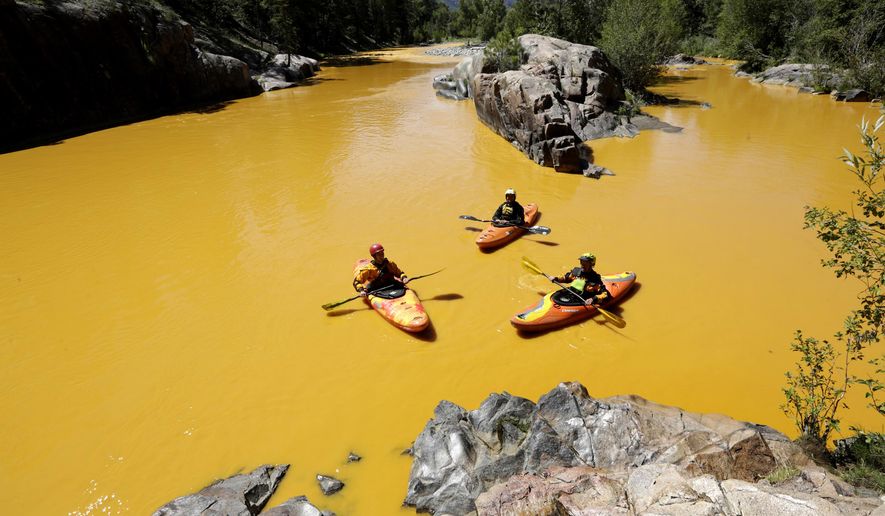The Environmental Protection Agency replaced a doctored video from the Gold King mine spill with the original Wednesday after being called on the discrepancy during a House committee hearing.
Rep. Bill Johnson, Ohio Republican, showed both versions during the hearing before the House Science, Space, and Technology Committee, pointing out that the version posted on the EPA website covers up the voice of a worker as contaminated water spills from the mine saying, “What do we do now?”
EPA spokeswoman Laura Allen said the redacted video was “posted by mistake.”
“The unredacted version was meant to be shared on the EPA website,” Ms. Allen said in an email. “We’ve since removed the redacted version and replaced it with the unredacted version, as was originally intended.”
The discrepancy did nothing to burnish the EPA’s image as Congress convened the first hearing to investigate the agency’s role in the Aug. 5 spill that sent 3 million gallons of orange wastewater into Colorado’s Animas River and New Mexico’s San Juan River.
Panel Republicans grilled Mathy Stanislaus, assistant administrator of the EPA’s Office of Solid Waste and Emergency Response, over whether the EPA was holding itself to the same standard as it would a private company, as well as why the EPA-led crew had failed to measure the water level behind the debris at the mine before the accident.
“Why were the warnings ignored?” asked committee Chairman Lamar Smith.
The Texas Republican later issued a statement saying that “the same standards that the EPA applies to private companies should also apply to the EPA itself. The EPA’s negligence is especially inexcusable since there were known procedures that could have prevented the river’s pollution.”
Meanwhile, Democrats argued that the region is peppered with old, inactive mines dating back to the late 1800s that have become environmental disasters waiting to happen.
“I am glad the EPA is taking responsibility for the mistakes and will work with all these communities impacted by these events,” said Rep. Ed Perlmutter, Colorado Democrat, in a statement. “But it’s important to keep this release in perspective and understand this incident points to a much larger problem that’s been 100 years in the making.”
He said a handful of mines along with the Gold King in Silverton, Colorado, release over 330 million gallons of contaminated wastewater each year into the Animas River, far more than the spill uncorked by the EPA.
Rep. Mark Takano, California Democrat, held up a large white ball symbolizing 330 million gallons next to a far smaller white ball representing 3 million gallons.
“So as a matter of proportionality, I find it curious that this committee is focusing on this and spending hours and hours and hours of time … when we should be talking about this,” Mr. Takano said, indicating the larger ball.
Mr. Smith responded, “I can’t wait to use the gentleman’s arguments the next time a private company dumps millions of gallons of toxic water into a pure river.”
A more in-depth Interior Department investigation is now underway.
Asked why the EPA waited 24 hours before notifying local and tribal authorities, Mr. Stanislaus said the agency did notify downstream users before the contamination reached them, and that the EPA is moving to improve the notification procedures.
But he was caught off guard when Mr. Johnson played the original and edited videos from the Aug. 5 accident showing contaminated water spilling from the mine.
The EPA has a disclaimer on its website saying that profanity from its videos had been removed and license plates blurred, but that otherwise the agency “did not edit the videos.”
“So you said you had no reason to believe that the EPA’s website had been altered. I’ve just given you reason because the evidence is there,” Mr. Johnson said. “The ’before’ video and the one that you posted on the website. Why did the EPA edit out the audio of the team on the ground saying, ’What do we do now?”
Mr. Stanislaus said he did not know why the videos would have been edited, prompting Mr. Johnson to ask, “After seeing both videos, do you think EPA’s website is misleading to the American public?”
Mr. Stanislaus said, “I can’t tell at this moment,” prompting Mr. Johnson to retort, “What do you mean you can’t tell? You just saw two videos, one that had it, one that didn’t, one that was clear and open, one that was posted by the EPA. How can you not tell?”
The EPA released an internal review three weeks after the spill noting that the crew opted not to use a drill hole to determine the water level, saying that it would have been “difficult and therefore expensive and technically challenging.”
⦁ Staff writer Anjali Shastry contributed to this report.
• Valerie Richardson can be reached at vrichardson@washingtontimes.com.




Please read our comment policy before commenting.